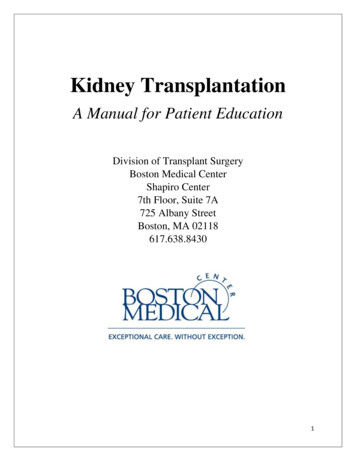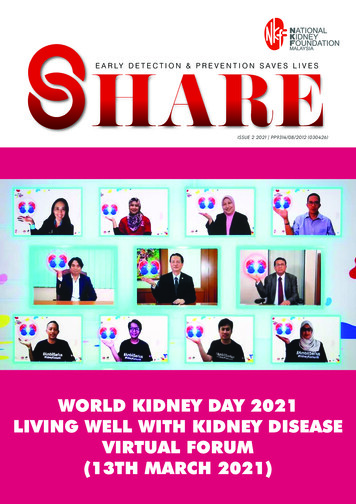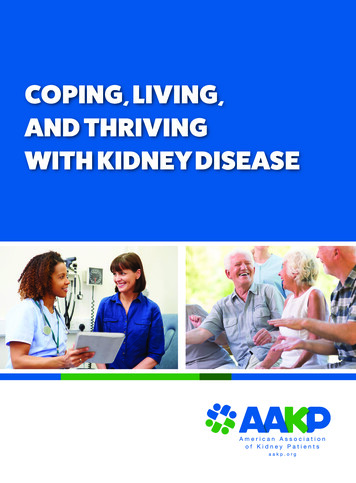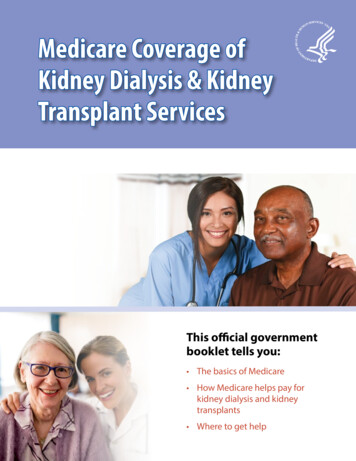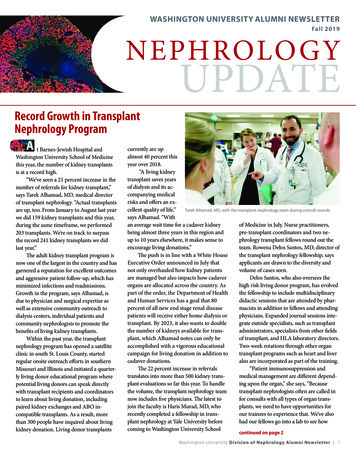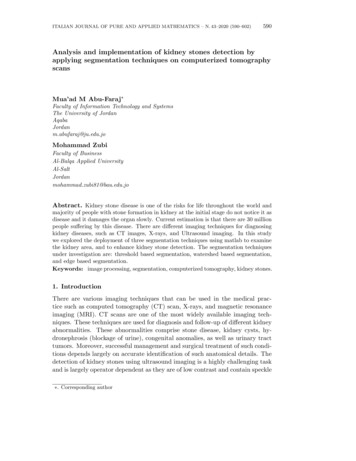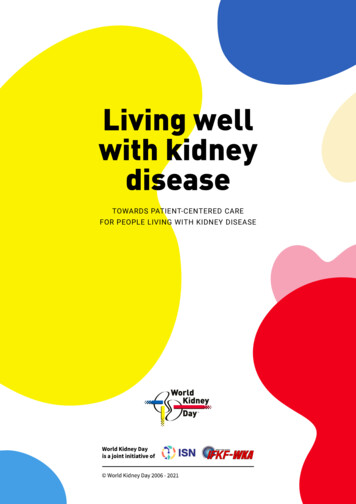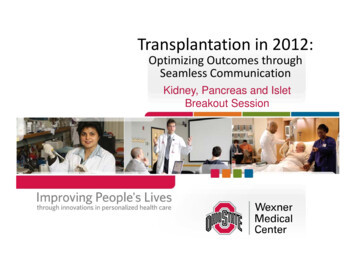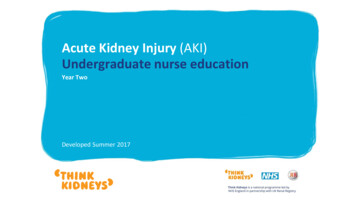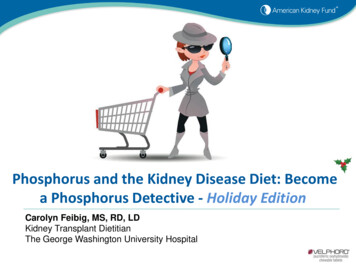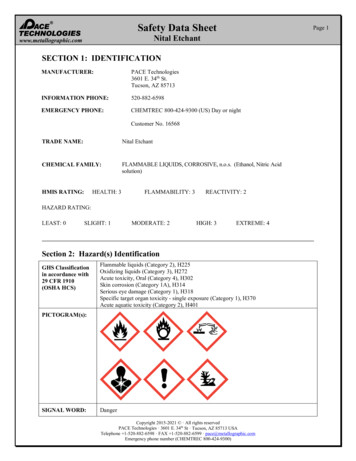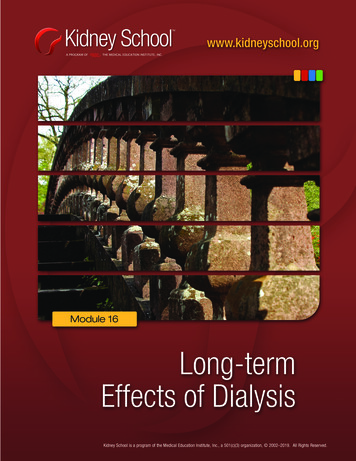
Transcription
A PROGRAM OFTHE MEDICAL EDUCATION INSTITUTE, INC.Kidney School is a program of the Medical Education Institute, Inc., a 501(c)(3) organization, 2002–2019. All Rights Reserved.
Module 16 – Long-term Effects of DialysisModule 16 – Table of ContentsChoosing the Life You Want. 16-3Heart Disease. 16-5Renal Osteodystrophy (Bone Disease). 16-11Amyloidosis . 16-16Neuropathy (Nerve Damage). 16-17Personal Plan. 16-23Take the Kidney Quiz!. 16-25Additional Resources. 16-26Please NoteUse of Kidney School does not replace the need to talk with your health care team about your care and your options.Legal DisclaimerThe information you find on the Life Options website or printed pages, including Kidney School, is provided “as is,” and to the extent permitted by law, the Life Options RehabilitationProgram, the Medical Education Institute, Inc., and their affiliates, employees, officers, board of directors, or shareholders give no warranty of any kind, either express or implied,including without limitation any warranties of condition, quality, performance, merchantability, fitness for a particular purpose, or non-infringement in relation to information,services, or products provided through or in connection with the Life Options website or printed pages. To the extent permitted by law, the Life Options Rehabilitation Program and theMedical Education Institute, Inc. disclaim all liability for any damages or injury caused by any failure of performance, error, omission, deletion, defect, access to, alteration of, oruse of record, whether as a result of breach of contract, tortious behavior, negligence, or under any other cause of action. The contents of the Life Options website and printed pages,including, but not limited to text, graphics, and icons, are trademarked materials owned or controlled by the Medical Education Institute, Inc. No permission is granted here foryou to reprint in whole or in part Life Options or Kidney School content, graphics, illustrations, photographs, or icons. (Revised March, 2015)d5)c4)a3)b2)c1)9)8)7)6)cddaCongratulations, you’ve finished the quiz! Here are the correct answers so you can see how you did:Module 16 – Kidney Quiz Answers16-216-
www.kidneyschool.orgThe great humorist Mark Twain once said,“Never put off until tomorrow what can be put offuntil the day after tomorrow.”This is classic Twain looking at life a little offcenter. But the reason we find it funny is that ithas some truth in it. When we face somethingtough or unpleasant, we often prefer to avoidit for as long as we can. Sometimes we ignoreit until it forces us to notice it.Some hard things in life can be put off orignored. But kidney failure isn’t one of them.It will demand your attention, even if you tryto pretend it doesn’t exist.This module is about long-term health problemsthat can occur with dialysis. By taking goodcare of yourself, you can delay or prevent someproblems that might otherwise arise down theroad. You can have more time, feel better, andbe able to do things you care about. We want youto be able to take steps to protect yourself, and livelong and well with kidney failure.Whether you’re new to dialysis and lookingdown the road, or you’ve been on it for years andare now running into some of these issues, thismodule is for you. At the end, we’ll give you aPersonal Plan that lists the main points we’vemade and reflects your action points.So, what matters most to you?Sometimes in the course of getting through one busyday after the next, we can lose track of our dreams:what we want out of life. What we want to do forothers. What we want to achieve or be or do.Here’s your chance to take a few moments andthink about your dreams. What inspires you inlife? What gives you the most joy? What are youlooking forward to? Check as many as apply:q Caring for my children and/or grandchildrenq Helping a loved one who needs meq Seeing my getmarriedq Seeing a loved one graduate from high schoolor collegeq Getting a college or graduate degree myselfq Finishing high school or getting a GEDq Taking a trip to:So, let’s get started.Choosing the LifeYou WantYour best bet to feel your best and avoid long-termeffects of dialysis is to make good choices andtake care of yourself. To do this, you need to trulybelieve that your life is worth living—and thatyou have something to live for.16-3
Module 16 – Long-term Effects of Dialysisq Helping people with:q Getting a promotion at workq Having a special birthday or eventq Getting marriedq Becoming good at a sport or hobbyq Winning the lotteryq Having a holiday celebrationq Becoming famousq Going to a family reunionq There is nothing for me to look forward toAre you putting limits on yourself because of yourdialysis and stopping yourself from doing thingsyou could do? It’s easy to take on a “sick role”.But with a chronic disease that won’t go away,focusing only on your illness can leave you feelingempty. Your life needs to be about more than justdialysis. What can you plan and look forward to?If you can’t think of even one to look forward to,you might be depressed. Signs of depression caninclude:n Not enjoying things you used to like16-416-It can be hard to sort out depression from kidneydisease or other health problems you may have.But depression can be treated. Getting help canimprove your outlook on life—and inspire youto take good care of yourself. Every dialysis clinichas a social worker with a master’s degree andtraining to help people who are depressed. Youcan learn more in Module 5—Coping withKidney Disease.Another option to improve a poor quality of lifemay be to change the type of dialysis you do.Treatments that work more like healthy kidneyscan reduce symptoms and help you sleep better.You may think more clearly and have more energy.To learn more about types of dialysis, read Module2—Treatment Options for Kidney Failure.A poor quality of life may make you think yourbest days are behind you. When you have severepain or other illness, a day may come when youchoose to stop dialysis. If so, talk with your lovedones and your care team. You are the only onewho can make this choice, but you’ll feel betterif those close to you know your thoughts. Youmay also want to talk with your minister, rabbi,priest, or imam. Most religions think of stoppingtreatment as letting nature take its course. Itis not suicide. If you choose to stop treatment,your doctor can refer you to Hospice, which canhelp you and your family. You would also have achance to gather your loved ones around you—and these can be treasured times that most peopledon’t have.n Loss of appetite (or eating too much)n Trouble sleeping (or sleeping too much)n Feeling irritable or angryn Feeling sad and downn Loss of hopeEmbracing life—and knowing why you do it—can guide you to make choices that will help youcreate the future you want.n Feeling worthless or thinking that everythinggoes wrong for youIn this module, we are going to focus on fourlong-term problems:n Having no energy, being exhausted
www.kidneyschool.org1 Heart disease1 Inside your cells2 Bone disease2 Between your cells3 Amyloidosis3 In your bloodstream4 Nerve damageHeart DiseaseHeart disease is the number one cause of deathfor people on dialysis—just as it is for otherAmericans. When you protect your heart, youimprove your chances of living long and livingwell on dialysis.Dialysis, fluid, and your heartMuch of how you feel after each dialysis treatment depends on how much fluid is removed,and how quickly. In the long-term, how fluid isremoved can affect your heart.When your kidneys fail, fluid builds up in yourbody in three “spaces”:Dialysis can only remove fluid that is in yourbloodstream. Only about 15% of the fluid inyour body is in your bloodstream at any given time.Trials and Tribulationsof Fluid RemovalFeel like you have the flu after a dialysis treatment? You’re not alone. If you have to take offa lot of fluid in a short time, you can feel prettywretched. Here’s how one patient describes it:“I always look the worst of all of the otherpatients when I come off of the machine. Itnever fails that I always feel not only tired, butvery weak. Sometimes I have a slight headacheor feel dizzy. I have tried everything.I always have to sit for a while (10 to 15minutes). I get on the scale, and then I goout to my car, and then have to sit a littlewhile longer so I can drive home. I alwayshead straight for the bed. The next morning,after enough sleep, I feel fine again.I know of some people who come off of dialysisfeeling great. I don’t get that. I can’t hardlyfunction then. I know of some people who goto work after dialysis, and I don’t know howthey do it. I feel weak climbing the stairs aftertreatment. What is wrong with me? My labslook great. It is just when I come off of thatmachine that I catch it hard. One of the thingsI miss about peritoneal is that I did not havethe ‘hangover’ that hemo gives me.” –Ed16-5
Module 16 – Long-term Effects of DialysisCardiac Emergency“I had quite an event this weekend. They thinkit was a problem with not taking enough fluidfrom me on dialysis and my dry weight shouldbe lower than they have it. Anyway, earlyFriday morning I had trouble breathing. Iwas gasping for air and afraid I was dying.I called 911 and the emergency team camewithin five minutes. They gave me oxygenand put in an IV. I was near passing out butthey made me stay awake. In the emergencyroom they kept up the oxygen and gave mesome morphine to ease my panic. They tookX-rays, etc.I had too much fluid in my lungs and itlooked for a while like I had congestive heartfailure. My blood pressure was up to 200over 125. They were ready to put a tube intomy lungs but my breathing got a little betterso they didn’t. Thank goodness! Then theyrushed me up to dialysis in the hospital. I feltmuch better after that as fluid from aroundmy lungs was taken out. Then they thoughtI might have had some heart damage, so theyran me through the CT scan, sound scan,simulated treadmill, blood work, etc. and saidthere may be damage to a small part on thebottom of the heart, but they would treat itwith medicine. I never had any chest pains,so they figure it was not a crisis at the moment.I am feeling pretty good now and came homeMonday. I hope to never have to go throughthat again!” –Jerry16-616-Dialysis takes fluid out of your blood. At the sametime, some of the fluid in and between your cellsslowly moves into your blood to replace it. Dialysiscan take fluid out of your blood faster than it canmove in. Even after a treatment, you may stillhave extra fluid in and between your cells.Taking off a lot of fluid in a short time can makeyour blood pressure drop. This can harm youraccess and give you painful cramps and a headache. You may even feel sick to your stomach orthrow up. It may take six hours or more to feelwell after a standard in-center hemodialysis (HD)treatment when a lot of fluid is taken off quickly.On peritoneal dialysis (PD), taking off a lot offluid can make you feel sick and washed out.Over time, extra fluid can build up in yourbody—and it can damage your heart.Left ventricularhypertrophy (LVH)Each day, your heart beats about 115,000 times. It’syour heart’s job to pump blood through your bodyso each cell gets the oxygen and nutrients it needs.Your heart has four pumping chambers; the largest is the left ventricle. If your body holds toomuch fluid, your heart has to work much harder.And if you have high blood pressure, your bloodvessels become stiff, which makes more workfor your heart, too. These problems can forceyour heart to work so hard that the left ventriclebecomes thick and enlarged. This is called leftventricular hypertrophy, or LVH.With LVH, overgrown, flabby heart muscle takesup space that should be used for pumping blood.When the heart can’t pump out all the blood thatcomes in, blood backs up into the lungs. In time,
www.kidneyschool.orgMedicine Can CauseDry Mouth and ThirstSome drugs can cause dry mouth or thirst, so askyour doctor or pharmacist about your drugs. Yourdoctor may be able to switch you to a drug thatdoesn’t cause this problem.Healthy HeartHeart with LVHthe heart can fail slowly—or quickly. LVH is theleading cause of sudden death in people on dialysis.The best way to avoid LVH is by keeping fluid levelsin your body as close to normal as possible all thetime. Also, if you have diabetes in control, keepingyour blood sugar steady will help keep you fromdrinking too much because you’re thirsty.If you have high blood pressure or water weightgain, eating less salt can help. Salty foods makeyou retain fluid. Having salt in your system alsomakes you thirsty so you drink more. This meansa high-salt diet is a double whammy for yourfluid intake. To learn more about eating lesssalt, read Module 9—Nutrition and Fluids forPeople on Dialysis.PD and LVHIf you need to use 4.25% dextrose bags often, oryou retain the solution and don’t get good drains,talk with your PD nurse. If your doctor prescribesblood pressure pills, take them as directed.Standard in-center HDand LVHOn standard in-center HD, the most importantthing you can do to prevent LVH is to follow yourfluid limits and take your blood pressure and“water-pills” as your doctor prescribes.Healthy kidneys work 24 hours a day, 7 days a week(168 hours a week). With 9 to 12 hours of treatment per week, you need to do part of the work ofcleaning your blood by drinking less fluid. If youchoose to do more dialysis (like daily or nocturnalhome HD), your treatment will remove more fluid,so you can have a more normal fluid intake.Your center may do sodium modeling (add somesodium into your blood) to make your treatmentsfeel better. If so, you may be left with extra saltthat can make you thirsty. This can make itmuch harder to follow your fluid limits—whichcan cause a vicious cycle. Eating less salt anddrinking less fluid may allow the staff to use lesssodium in your modeling program.Daily or nocturnal HDand LVHDaily or nocturnal HD help you protect your heartby taking off a lot of fluid, but slowly and gently.Most people who do home HD treatments can takefewer blood pressure pills—maybe none at all.Statins and heart failureLike millions of American adults, you may havehigh cholesterol. Many people are prescribed astatin drug for high cholesterol. Statins lower16-7
Module 16 – Long-term Effects of Dialysischolesterol by blocking a certain pathway in yourbody. Some common statins include:n Lipitor (atorvastatin)nPravachol (pravastatin)nCrestor (rosuvastatin)nZocor (simvastatin)nLescol (fluvastatin)n Vytorin (simvastatin ezetimibe)Testing your heartThe good news is that LVH can get better. If youdon’t have it, you can help prevent it. And ifyou do have it, you can take steps to improveyour heart health. Ask your doctor about testingfor LVH—you can have it with no symptoms(or you may be short of breath, dizzy, or havechest pain).Research has found a number of tests that cancheck for the problem. Check off the ones youwant to ask your doctor about:q Echocardiogram. An “echo” uses painlesssound waves to show your pumping chambersand valves. It will show the size of your leftventricle and how well it works. The resultscan predict future problems.q 24-hour blood pressure (BP). WithDo You Need CoQ10?If you take a statin, ask your doctor if you shouldtake the supplement Coenzyme Q10 (CoQ10), too.Statins use up CoQ10, which is a key enzymethe body needs for energy. Not having enoughCoQ10 can cause congestive heart failure.16-816-a small machine on your belt and a cuff onyour arm, your BP can be checked all day andnight. This tells your doctor much more thana single check. If your BP is high all the timeor does not drop at night (it should), you needto take steps to lower it.q Bioimpedance analysis (BIA). BIA cancheck for fluid overload by looking for fluid inand outside of your cells. This technique usessensors on your head and neck (one type iscalled Bio-Z). It is painless and non-invasive.BIA predicts LVH in people on dialysis.q C-reactive protein (CRP). A CRP bloodtest measures inflammation, which has beenlinked to heart damage in people on dialysis.If tests show that you have LVH, some things youcan do include:Quit smoking. Besides causing lung and kidney damage, tobacco use has been found to raisethe risk of LVH by 42%. If you smoke, stoppingcan help protect your heart. Can’t do it alone?Ask your doctor about prescription drugs to helpyou, or join a stop-smoking program.Eat enough protein. Low serum albumin(protein) levels seem to make LVH get worse faster. If you can’t eat enough protein, you may notbe getting enough dialysis to keep up your appetite. Getting more treatment can help your heart.
www.kidneyschool.orgWILD SWINGS IN LEVELS OF FLUID AND WASTESAsk about ARBs and ACE inhibitors. Someblood pressure drugs in these two classes havehelped to reverse LVH.Get bone disease treated. Having renal bonedisease makes LVH worse. Taking active vitaminD (calcitriol) has been shown to improve it, so, ifyour doctor says it’s safe, you can do your bonesand your heart a favor at the same time. We’lltalk more about bone disease on page 16-11.If you are on standard in-center HD, getmore dialysis. Daily and nocturnal HD removemuch more fluid from in and between your cells.These treatments can help prevent (or treat) LVH.In a year-long study, both options shrunk left ventricles much more than standard in-center HD.Nocturnal HD improves LVH in patients with knownheart problems. The treatment helps make arteriesless stiff so they respond as they should to stress.People who switched from standard to nocturnalHD had less LVH—and lower blood pressure.Your dialysis schedule can also affect your riskof sudden death from LVH. Two large studiesfound twice the risk of sudden death on Mondayor Tuesday (after the weekend) than on anyother day of the week. The ups and downs oftreatments three days per week (see graphs aboveright) are hard on the heart. Doing treatmentsat least every other day is more gentle.Dialysis: removing toxinsAs we said before, how you feel after a dialysistreatment is all about removing fluid. In thelong term, how you feel depends on otherillnesses you may also have—and on howwell toxins are removed.Homeostasis45 HoursMON45 HoursTUESWED68 HoursTHURSFRISATSUNNo normal levels of water or wastesMORE NORMAL RANGE OF FLUID AND WASTESwithstandard in-center HDHomeostasis21 HrsMON21 HrsTUESWED21 Hrs21 HrsTHURS21 HrsFRISAT45 HrsSUNNormal levels of water and wasteswith PD, daily, or nocturnal HDThink of a dialyzer as a filter you might use topan for gold. The holes need to be big enoughto let toxins (small gravel and rocks) out—butnot so big that they let blood cells or protein(gold!) escape.In your blood, there are three main sizes of toxinsto remove, so they don’t build up to harmful levels:1 Small molecules (like urea) easily fitthrough dialyzer holes. They are very easyto remove. Scientists have found 68 smallmolecule toxins.2 Middle molecules (like beta-2-microglob-ulin—more about this later), are larger andharder to remove. There are ten middlemolecule toxins.3 Large molecules (like cytokines, hormone-like signal proteins) are even harder toremove. Twelve large-molecule toxins havebeen found.The more middle and large molecules your treatments can remove along with the small ones,the more likely you’ll feel well for a long time.Middle and large molecules take time to remove.16-9
Module 16 – Long-term Effects of DialysisThey pass through the dialyzer very slowly.“Adequacy” of dialysis tests are based on smallmolecules, but it is middle and large ones thatcan cause problems for you down the road.Removing toxins with PDSince you do PD all day long or for a long timeeach night, it can do a very good job of removingmiddle and large molecules.Over time, your peritoneum may remove fewertoxins and less fluid. One sign that this may begoing on is if you start to retain the PD fluid.A peritoneal equilibrium test (PET) can alsotell. You can help protect your membrane if you:n Use careful technique and avoid infection.n Watch your fluid intake so you can use asfew 4.25% bags as you can (the sugar contentin 4.25% bags can damage the peritoneallining).n Use icodextrin PD fluid for the night dwellinstead of a fluid based on sugar.Removing toxins withstandard in-center HDStandard in-center HD does a good job of takingout small molecules. It does not do as well withmiddle and large molecules.Longer HDTreatments Longer LifeA study of more than 22,000 people on dialysis allover the world found that longer HD treatmentswere linked with longer life. In fact, each extra30 minutes of treatment improved the chance ofsurvival by 7%. With dialysis, more is better!16-1016-An option for better toxin removal with standardHD may be to use two dialyzers at each treatment.In a small study of people who weighed more than176 lbs. (80 kilos), health status was better for a yearwhen two dialyzers were used. Reuse of the dialyzerswould bring down the cost. It can be tricky to dowith machines that were built for one dialyzer, though.Removing toxins withdaily HDDaily HD does a good job of taking out smallmolecules—and a good job with middle andlarge molecules.Removing toxins withnocturnal HDNocturnal HD does the best job of taking outmolecules of all sizes. If you are doing three nightsper week of dialysis, a way to remove even moretoxins (and fluid) is to add a night or two. Thiscan’t always be done—Medicare pays for threetreatments per week. Your doctor may be ableto write a letter to Medicare to see if a fourth (ormore) treatment would be paid for. If you have ahealth plan through a job, it may pay for the othertreatments. People who do nocturnal treatmentsfive or six nights per week say they feel even better.Most people still have some kidney function whenthey start dialysis. Keeping this function as long asyou can helps dialysis work better. Below are someways that you can help keep your kidney function.Which ones can you do? Check all that apply:q Quit smoking if I smoke. Smoking causesdamage to the kidney filters.q Keepmy blood pressure in the targetrange my doctor gives me.q Keepmy blood sugar in the targetrange if I have diabetes.
www.kidneyschool.orgq Protectyour kidneys from X-raycontrast dye. The radiologist can dilute thedye, flush it out of your body with saline, usea less harmful dye, or prescribe a drug calledmucomyst that may help prevent damage.q Avoidnon-steroidal pain pills (calledNSAIDs), like ibuprofen and naproxen. Somecommon brands are Advil , Aleve , andMotrin , but there are many others. Not sureif a pill you take is an NSAID? Ask your pharmacist or doctor.q your kidney doctor before you takeAskany herbs. Some can damage the kidneys.q about a new drug before you takeAskit. Some drugs can harm the kidneys, andany drug that you are allergic to may causekidney damage. Know what you’re taking—your pharmacist can tell you if a drug canhurt your kidneys. If another doctor prescribesa drug for you, ask your nephrologist beforeyou take it.Renal Osteodystrophy(Bone Disease)Renal osteodystrophy is bone disease due to kidneyfailure. The problem is quite common—mostpeople on dialysis have some degree of it. Bonechanges can start many years before symptomsappear, like:n Joint painn Bone painn FracturesTo understand renal osteodystrophy, you need toknow a little about your bones. Bones have threekey jobs in your body:1 Hold up your body and protect your organs2 Store minerals your body needs3 Make red blood cellsBones seem solid, even rock-like. But if youlook at them under a microscope, old boneis being broken down, and new bone is beingformed. This is called “remodeling”—and it’slike redoing your kitchen. If you tear down wallswithout leaving supports, the ceiling may fall in.If old bone breaks down faster than new bonecan replace it, your bones could become weak.Weak bones can break.Healthy kidneys help ensure healthy bones bykeeping the bone building minerals (calciumand phosphorus) in balance in your blood.16-11
Module 16 – Long-term Effects of DialysisCalciumCalcium is the most common mineral in your body.It’s needed in your blood in very precise amounts to:n Send nerve signalsn Help your muscles workn Aid in clotting your blood when you’re hurtn Control fluid balance in your cellsYou get the calcium your body needs by eating foodsthat contain it. Dairy is a good source of calcium.Most calcium in your body is stored in your bones—like a bank. Remodeling your bones is a way foryour body to take calcium out of your bank.The National Kidney Foundation’s Kidney DiseaseOutcomes Quality Initiative (NKF KDOQITM)Guidelines for people on dialysis say that yourblood calcium level should be at the lower end ofthe normal range for your center’s lab. In mostcases, this means from about 8.8 to 9.5 mg/dL,and not higher than 10.2 mg/dL.PhosphorusPhosphorus is a common mineral that your bodyneeds for energy. It’s found in nearly all foods,especially:n Meats n Chocolaten Dairy productsn Cola drinksn Whole grainsn Dried beansLike calcium, phosphorus is stored in your bones.Remodeling lets small amounts of it into yourTurning to Stone: Calcified Blood VesselsYou know that toomuch phosphoruscauses itching andbone problems.Having the wronglevels of calcium andphosphorus in your blood can also harm yourblood vessels. Calcium phosphate crystals canform in arteries and veins, making them calcify(turning them—quite literally—to stone).Stone-like blood vessels can’t respond tochanges in your activity level. Stone-likeheart valves can’t pump your blood, whichcan lead to heart failure. Research has foundthat phosphate binders based on calcium, likeOs-Cal or PhosLo , can cause this problemor make it worse if calcium levels are toohigh. Non-calcium binders, like Renagel ,16-1216-Fosrenol , or Renvela , are less likely to makeblood vessels calcify, but they cost more.When you get more dialysis (e.g., daily ornocturnal HD), or have a transplant, you don’tneed as many binders. This is something tothink about to help you live long and well withkidney failure.Your doctor can see how much of a problemyou have with blood vessel calcification bydoing an X-ray, ultrasound, CT scan, or electron beam tomography (EBT). An echocardiogram (echo) test to see how well your heartpumps can also help.Do you have calcified blood vessels now? Gettingmore dialysis may help shrink the deposits. Also,osteoporosis drugs called bisphosphonates showsome promise for treating this problem.
www.kidneyschool.orgblood. Healthy kidneys remove extra phosphorusfrom your blood. When the kidneys fail, extraphosphorus can bind with calcium to createsharp, calcium phosphate crystals. These crystalscan cause itching, skin sores, and worse. In thelong term, having the wrong levels of phosphorusin your blood can harm your bones.Phosphorus is hard to remove with dialysis—andeach time you eat, you take in more. The NKFKDOQI Guidelines for people on dialysis say thatyour phosphorus level should be between 3.5 and5.5 mg/dL. To stay in this range, most people ondialysis need to eat fewer high-phosphorus foodsand take some phosphate binders with each mealand snack. These drugs bind with phosphorusand remove it in your stool.Getting more dialysis by doing daily or nocturnaltreatments will remove more phosphorus so youneed fewer binders and can eat a more normaldiet. In fact, people who do nocturnal HD 5 orWhen Crystals Attack!Extraskeletal Calcification & CalciphylaxisA high calcium-phosphorus product (see page16-14) means extra calcium and phosphorusare in your blood, where they can form crystals. You may find that you have bone whereit doesn’t belong. Extraskeletal calcificationmeans bone is forming outside your skeleton.This can happen in your eyes, blood vessels,heart, lungs, or other organs. It may show upas knobs or lumps on top of bones, in jointsor on tendons. In some cases, a surgeon canremove these bone lumps to help improvefunction.nWorse, the crystals can harm blood vesselsand even cut off blood flow to a finger or toe,a whole limb, or soft tissue. This problem—calciphylaxis—is painful and can be fatal. Itmay occur in about 4% of people on standardHD. It starts as red or purple skin marks (oftenon both arms or legs in the same spots). Theymay look like bruises. A skin biopsy showscalcium in the tissues. The marks turn blackas the skin dies, and turns into ulcers that growlarger and won’t heal. People with diabetes areat a higher risk. Treatment for calciphylaxismay include:nnnnnn Phosphate binders – These help pullextra phosphorus out of the blood. Antibiotics – It is vital to prevent infectionin the skin ulcers. Sodium thiosulfate – New studies havefound that this drug, which pulls calciumout of the body, may be able to help. Thedrug is most often given in a vein, but maybe given into the peritoneum. Kidney
for people on dialysis—just as it is for other Americans. When you protect your heart, you improve your chances of living long and living well on dialysis. Dialysis, fluid, and your heart Much of how you feel after each dialysis treat-ment depends on how much fluid is
